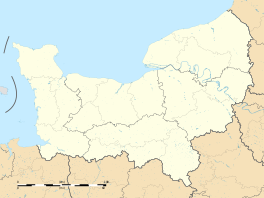Bolbec
| Bolbec | ||
|---|---|---|

Town hall
|
||
|
||
| Coordinates: 49°34′N 0°28′E / 49.57°N 0.47°ECoordinates: 49°34′N 0°28′E / 49.57°N 0.47°E | ||
| Country | France | |
| Region | Normandy | |
| Department | Seine-Maritime | |
| Arrondissement | Le Havre | |
| Canton | Bolbec | |
| Intercommunality | CA Caux vallée de Seine | |
| Government | ||
| • Mayor (2008–2014) | Dominique Metot | |
| Area1 | 12.24 km2 (4.73 sq mi) | |
| Population (2006)2 | 12,237 | |
| • Density | 1,000/km2 (2,600/sq mi) | |
| Time zone | CET (UTC+1) | |
| • Summer (DST) | CEST (UTC+2) | |
| INSEE/Postal code | 76114 /76210 | |
| Elevation | 29–142 m (95–466 ft) (avg. 129 m or 423 ft) |
|
|
1 French Land Register data, which excludes lakes, ponds, glaciers > 1 km² (0.386 sq mi or 247 acres) and river estuaries. 2Population without double counting: residents of multiple communes (e.g., students and military personnel) only counted once. |
||
1 French Land Register data, which excludes lakes, ponds, glaciers > 1 km² (0.386 sq mi or 247 acres) and river estuaries.
Bolbec is a commune in the Seine-Maritime department in the Haute-Normandie region in northern France. Its inhabitants are called Bolbécais or Bolbécaises.
A farming, quarrying and light industrial town situated at the heart of three valleys in the Pays de Caux, some 19 miles (31 km) northeast of Le Havre. It is the source of the river Commerce, though here it is known as the river Bolbec. The town has many small lanes (ruelles) with some pretty houses.
The first written record of the town dates from the end of the 11th century, as Bolebec. Archeological discoveries indicate that the site has been inhabited since ancient times. The first lord of Bolbec was Osbern de Bolbec (around 992) and the last was the Duc de Charost who was executed during the French revolution.
Bolbec developed thanks to the numerous mills which lined the river banks through the town. These mills, numbering 14 in the middle of the 19th century, allowed the development of a textile industry based on water power, and later steam, to power the machinery.
Today, only three mills remain: one at the source of the river in the grounds of the Oril factory; one at Vallot; and one in the Ruelle Papavoine.
At the end of the 18th century, a number of manufacturers installed themselves at Bolbec to produce "Indiennes" (printed textiles). On the eve of the Revolution, Bolbec had 18 factories. In 1806, there were 27 producing Indiennes employing nearly 800 workers.
The importance of textiles in the Bolbec Valley was recognised by the state with the creation of the Chambre des Arts et Manufactures in 1806 (which became the Chamber of Commerce and Industry) and further, with the creation of a Conseil des Prud’hommes in 1813. However, over the years the textile industry suffered economic crises and by the end of the 19th century there was just one indiennerie remaining.
...
Wikipedia



